#mitchell beaupre
Explore tagged Tumblr posts
Text
324 - Devil in a Blue Dress (w/ Mitchell Beaupre!)

This week's episode is a callback to our beloved 100 Years, 100 Snubs May miniseries: Mitchell Beaupre joins us to talk about 1995's Devil in a Blue Dress! Carl Franklin emerged with the indie success of crime thriller One False Move and moved onto studio filmmaking with Devil in a Blue Dress, starring Denzel Washington as a veteran hired to find a missing woman. The film was a smart noir exercise that nevertheless didn't quite catch on with audiences, though critics were taken with an unpredictable supporting player, Don Cheadle.
This episode, we discuss the controversy over 1995's all white acting nominees and the origin story quality of the film's story. We also talk about Franklin's unique awards haul for One False Move, Washington's atypical lack of love interest costars, and how Cheadle's performance feels like it has more screen time than it does.
Topics also include 1995 Best Supporting Actor, 2003 Entertainment Weekly as Oscar gateway, and Jennifer Beals as anti-femme female.
The 2012 Academy Awards
Mitchell interviews Carl Franklin
Vulture's Movies Fantasy League
Subscribe:
Patreon
Spotify
Apple Podcasts
#Carl Franklin#Denzel Washington#Don Cheadle#Tom Sizemore#Jennifer Beals#Best Supporting Actor#Maury Chaykin#Terry Kinney#Academy Awards#Oscars#movies#Lisa Nicole Carson
2 notes
·
View notes
Text
Mitchell Beaupre’s Top 10 Films of 2023
http://dlvr.it/T0cKFS
0 notes
Photo
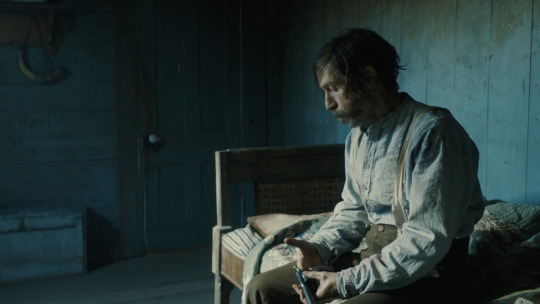
Work Horse.
Taking on a rare leading role in his decades-spanning career, national treasure Tim Blake Nelson speaks with Mitchell Beaupre about demystifying heroes, reinventing genres and something called a quiche Western.
“This film is unapologetic about all the tropes that it’s deploying in service of telling the story... You’ve got a satchel full of cash. You’ve got gunslinging, physical violence, and feeding somebody to the pigs.” —Tim Blake Nelson
Described by Letterboxd members as “a national treasure” who “makes everything better”, Tim Blake Nelson is a journeyman actor who has tapped into practically every side of the industry since making his feature debut in Nora Ephron’s This Is My Life back in 1992. Whether you are a Marvel fanatic, a history buff or a parent trying to get through the day, the actor’s distinctive presence is a charming sight that’s always welcome on the screen.
Tim Blake Nelson is one of those rare actors who unites all filmgoers, a man genuinely impossible not to love, which certainly seems to be the case for Hollywood. Checking off working relationships with directors ranging from Terrence Malick and Ang Lee to Hal Hartley and Guillermo Del Toro, Nelson has covered the boards, even crossing over into directing and writing, both in films and on the stage.
Yet, despite being a renowned talent who can take a smaller supporting role in a massive Steven Spielberg blockbuster starring Tom Cruise and carry the film, Nelson-as-leading-man sightings have been few and far between. In fact, it’s quite a struggle to find a film with Nelson in a leading role, as even playing the titular role for directors who understand his greatness still results in him only appearing in the opening section of an anthology feature.

At last, the leading role Nelson fans were in need of has arrived in the form of Old Henry, a new Western from writer/director Potsy Ponciroli. Nelson plays the eponymous Henry, a widowed farmer with a mysterious past who makes a meager living with his son (Gavin Lewis), doing his best to leave his old life behind and hide away from the world. Things get complicated when Henry stumbles upon a satchel of cash and a wounded stranger (Scott Haze), bringing them both into his home. Soon, a dangerous posse led by an intimidating Stephen Dorff comes calling, setting the stage for an old-fashioned throwdown in this twisty Western siege thriller.
Premiering at the Venice Film Festival, Old Henry has been warmly received on Letterboxd. “Old Henry feels like the culmination of Tim Blake Nelson’s twenty-plus-year career, but from another dimension, where he’s highly regarded as a leading man”, writes Noah, speaking not only to the strength of Nelson’s performance, but also to the fact that this leading role shouldn’t be such a rarity. Todd awards Nelson the prize for “Best Facial Hair in a 2021 film”, before applauding the actor for pouring “every emotion in his body to play Henry”.
Letterboxd’s East Coast editor Mitchell Beaupre saddled up for a chat with Nelson about the intentional hokiness of the Westerns that made him fall in love with filmmaking, how the Coen brothers put other directors on notice, and the fatherly joy of keeping it all in the family.
I’ve seen a lot of interviews with you discussing your career as an actor, a writer, and a director. You always speak with such reverence for the art. Where does that passion come from for you? What made you want to pursue this field? Tim Blake Nelson: It’s funny, doing these interviews for Old Henry has been reminding me of my introduction to filmmaking as an art. I’ve realized that I had never quite located it, but it really started with the Sergio Leone Westerns, which I would see on television when I was growing up in Oklahoma in the ’70s. Before that, going to the cinema was always invariably a treat, no matter what the film, but I would just be following the story and the dialogue.
The Sergio Leone movies were the first ones that exposed subjectivity in telling stories on film to me. That was where I became aware of the difference between a closeup and an extreme closeup, or how you could build tension through a combination of the angle on a character with the editorial rhythm, with the lens size, with the music in addition to the dialogue and the story.
How old were you when this shift in your understanding of cinema was happening? I think it was across the ages of ten and eighteen, where I suddenly realized that this was an auteur here, Leone. There was a guy behind all these movies I was seeing—and in Oklahoma, you could see a Sergio Leone movie every weekend. This was a man making deliberate and intelligent decisions in everything that I was seeing.
I started noticing that a character was in a duster that goes all the way down to his boots, even though that’s not necessarily accurate to the Old West. That’s something else. Also, why is he wearing it in the desert? Would that have been very practical? And look at that cigar Clint Eastwood is smoking. It’s not smooth, it looks like it was a piece of tree root. Then later I learned it’s a particular kind of Italian cigar, but somehow it was defining this genre of Western. I marveled at that, and found it unbelievably thrilling to discover. I loved the stories and the dialogue and the intentional hokiness of it all. All of it was conspiring to teach me to venerate this form.
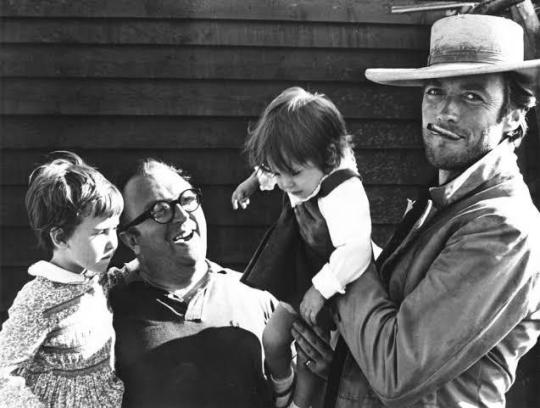
Sergio Leone, his daughters, and Clint Eastwood on the set of ‘The Good, the Bad and the Ugly’ (1966).
The connection there is interesting between the Leone Westerns to where Old Henry is at now. You’ve talked before about how the Western genre is one that is reinvented over and over throughout the years— Oh, you do your homework!
I try my best! What would you say defines the current era of Westerns that we’re seeing, and how the genre is being reinvented? Well, Joel and Ethan [Coen] did a lot of mischief, in a good way, with The Ballad of Buster Scruggs. Genres are always about genres, in addition to their story. So, I would say that Buster Scruggs is the quintessential postmodern Western, if you look at it as one movie instead of as an anthology, because it celebrates the history of the form. The magic of that movie is that it engages you in each story while also being a meditation on death. That’s what connects each one of those tales, and then it’s also a meditation on storytelling to boot. In the final chapter, you have a character talking about why we love stories, and he’s telling it to a bunch of people who you’ll learn are all dead.
The stories are a way of delaying the inevitable mortality. I mean, look at that. It’s such an accomplishment. With that movie, I think Joel and Ethan put filmmakers on notice that Westerns had better always be also about Westerns, because whether you like it or not, they are. I think they probably came to understand that when they were making True Grit, although knowing the two of them they probably understood it already.
Do you feel there’s a direct correlation between a movie like Buster Scruggs and Old Henry, in this era of postmodern, revisionist Westerns? How it impacts a movie like Old Henry is that you have Potsy embracing the Western-ness of the movie. This film is unapologetic about all the tropes that it’s deploying in service of telling the story. You’ve got the cantankerous old man hiding a past, who’s a maverick who wants to keep the law and the bad guys off his property. He wants to be left alone. You’ve got a satchel full of cash. You’ve got gunslinging, physical violence, and feeding somebody to the pigs. Yet, it’s all accomplished without irony in a very straightforward way that is utterly confident, and in love with the genre.
I think ultimately that’s why the movie works, because it’s very front-footed. It’s not hiding from you. It’s not deceiving you and trying to tell you it’s something that it isn’t. It’s a good, straightforward Western.
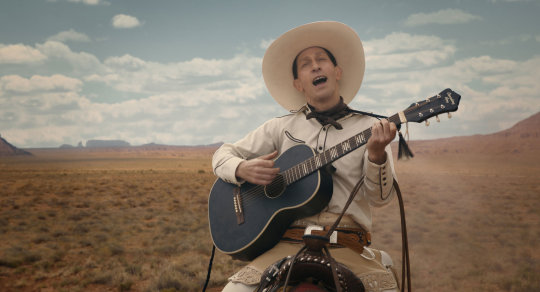
Tim Blake Nelson as the titular singer in ‘The Ballad of Buster Scruggs’ (2018).
That’s a bit different from those Leone Westerns, with all of their anachronisms. I remember when the movie Silverado came out when I was growing up, and people were calling it a “quiche Western”, which was funny. That was what they would call it in Oklahoma because it had a bunch of movie stars in it, who weren’t known for being in Westerns. It was the Sergio Leone crowd calling it that. I went and saw it, wondering, “Well, if it’s a quiche Western, then why is everybody talking about it?” I saw it, and I loved it. Those folks putting it down like that were wrong. It’s actually a straightforward, hard-boiled, hardcore unapologetic Western. You don’t like some of the movie stars in it, but get over it. The reason that movie works is because it’s straight-ahead and well-told, and I think that movie holds up.
Old Henry is the same kind of animal. It’s more in the tradition of Sergio Leone—or, actually, I would say more in the tradition of Unforgiven. That was a big influence on Potsy.
Unforgiven was marvelous in the way it demystified that old black hat/white hat mentality of Westerns, opening up a more multi-dimensional understanding. You’re no stranger to that. A series like Watchmen takes that approach with superheroes, who in a sense hold the position now that Western heroes used to hold culturally. Do you find there’s more of a demand these days to challenge those archetypes who used to be put on pedestals—be they superheroes, cowboys, police—and provide a deeper analysis? Absolutely, yes. At the same time, I think the demystified Western hero goes back to John Wayne in The Searchers. I think it really started with that character, one of the greatest characters ever in a Western. There’s One-Eyed Jacks, with Marlon Brando, which was made just after The Searchers, and again embracing this concept of an extremely complicated man. I don’t think you get the Sergio Leone movies without that.
I always think of McCabe & Mrs. Miller as a Western that was doing something totally different than anything I had seen before. That’s another one, with that final image with the character smoking opium, going into oblivion after the demise of Warren Beatty’s very flawed character, after you’ve watched what it has taken to really build that town. You have a director, Robert Altman, making the deliberate choice to shoot in order so that they can build the town while they’re shooting the movie, and you really get the cost of it. I think there’s a lot of history to get to a place where a movie like Unforgiven can happen. Then Clint comes along and, as he often does, moves it forward even more.

Gavin Lewis as Henry’s son Wyatt in ‘Old Henry’.
That’s a film that tackles legacy, as does Old Henry, which at its core is ultimately about the relationship between a father and his son. You got to work on this film with your own son, coincidentally named Henry, who was part of the art department. What is that experience like, getting to share your passion with your son on a project together? Well, I think something that is true for the character of Henry and for myself, and perhaps all of us, is that we all want our kids to have better lives than ours. I want that to be true in every respect. Mostly, I want them to be more fulfilled than I have been. My kids look at me when I say that and say, “Thanks a lot Dad for raising that bar”, because they see that I have a pretty good life. Which I do, but I still think they can be more fulfilled than I am, and I want that for them. One of the great privileges of this movie was to watch my son—who was the on-set decorator—work his ass off.
Those are the words of an incredibly proud father. He’s a work horse, and he’s learning about filmmaking, and I think on his current trajectory he will go beyond where I’ve gone as a filmmaker, directing more movies than I’ve been able to direct. Do a better job at it, too. He’s also a singer-songwriter, and I think he can have a venerable career doing that if he wants, but he wants to make movies too, and I hope that’s going to happen for him. It was a thrill to watch him do the work, the twelve- and fourteen-hour days, and after every take resetting and making sure everything was right. It felt like an accomplishment to see him take on that responsibility and do the real work every day.
Related content
SJ Holiday’s lists of Essential Neo-Westerns and Essential Modern Westerns
The Best Neo-Westerns of the 21st Century, according to JS Lewis
Our interview with Slow West director John Maclean
Follow Mitchell on Letterboxd
‘Old Henry’ is in US theaters now and on VOD from Friday, October 8.
#tim blake nelson#old henry#western#westerns#western movies#sergio leone#clint eastwood#stephen dorff#letterboxd#mitchell beaupre#coen brothers#coen bros#buster scruggs#joel coen#ethan coen
20 notes
·
View notes
Link
It's me on The B-Side: A Film Stage Podcast a talking some deep-cut Drew Barrymore films 🎙️
2 notes
·
View notes
Text
Artifact Series E
E. J. Pennington's Motorcycle Motor
E. T. A. Hoffman's Nutcracker
Eadweard Muybridge's Zoopraxiscope
Ear of Dionysius
Ear-Worm Record Player *
Earl J. Hickey's List
Earl W. Bascom's Horseshoe
Earle Nelson's Worn Bible
Easter Island Conch Shell *
Easton-Bell Aluminum Baseball Bat
Eau De Via Faucet *
Ebenezer Thorndike's Lobster Trap *
Eccentric Tree Seeds
Echo's Belt
Ed Bishop's Cave Lantern
Ed Gein's Shovel
Ed Hardy's Shoelaces
Ed Walsh's Spitball
Ed Wood's Director Chair
Ed Wood's "Glenda" Dress
Eddie Arcaro's Jockey Goggles
Eddie Brown's Tap Shoes
Eddie Hasha’s Wood Planks
Eddie Leonski's Hobby Hat
Eddie Murphy's Microphone
Edgar Allan Poe's Bust of Athena
Edgar Allan Poe's Quill Pen and Notebook *
Edgar Allan Poe's Walking Cane
Edgar Bergen's Stool
Edgar Hollis' Cricket Ball
Edmond Halley's Telescope
Edmond Locard's Microscope Lens
Edmund Evans’ Printing Press
Edmund Musgrave Barttelot's Cane
Edmund Hillary's Climbing Gloves
Edmund Mcllhenny's Hot Sauce
Edna St. Vincent Millay's Candle *
Edouard Beaupre's Display Case
Edsel Ford Fong's Apron
Eduard Khil's Suit
Edvard Grieg's Metronome
Edvard Munch's Original Painting of "The Scream"
Edward I of England's Coal
Edward Murphy's Insignia
Edward Abbey’s Monkey Wrench
Edward Adamson's Colored Pencils
Edward Bellamy's Cornerstone
Edward Bernay's Cigar
Edward Bowes’ Gong
Edward Covey's Flogging Whip
Edward Henry Potthast's painting "Coney Island"
Edward Hughes Ball Hughes' Cravat
Edward Jenner's Syringe
Edward John Dent's Chronometer
Edward Leedskalnin’s Ball Bearings
Edward Lowe's Prayer Censer *
Edward Makuka Nkoloso’s Oil Drum
Edward Mordake's Second Face
Edward Mueller's Counterfeit Dollar Bill
Edward O. Thorp's Casino Chip
Edward O. Thorp & Claude Shannon's Pocket Computer
Edward Oxford's Percussion Caps
Edward Teach's Shackles
Edward Teach's Sword
Edward Teller's Micro-Fission Reactor *
Edward Weston's Lightbulb
Edwin Abbott Abbott’s Ruler
Edwin Albert Link's Flight Simulator
Edwin Armstrong's Radio Parts
Edwin Binney's Candles
Edwin F. Glenn's Water Funnel
Edwin H. Land's First Polarized Sunglasses
Eepybird's Sticky Notes
Eero Saarinen's Model of the Gateway Arch
Egg of Columbus *
Eggnog from the Eggnog Riots
Egon Ronay's Crab Cracker
Egyptian Sex Manuals
Egyptian Sphinx Slab *
Eiffel Tower Parrot Cage
Eilmer of Malmesbury's Wings
El Cerrito Ouija Board
Elaine Esposito's Pillow
Elder Zhang Guo’s Fish Drum
Elderly-Killing Thermostat
Eldritch 1953 Buick Roadmaster
Electrified Birch
Elements of Harmony
The Elephant of the Bastille
Elephant Candle Holders
Eli's Bible
Eli Lilly’s Pills
Eli Whitney's Vest
Elian Gonzalez' Worker's Gloves
Elias Carter's Church Spire
Elias Garcia Martinez's Paint Brush Set
Elijah's Cup
Elijah Parish Lovejoy’s Printing Press
Eliphas Levi's Pentagram
Eli Robins' Scalpel
Elisabet Ney's Black Artist Frock Coat
Elisabeth Kübler-Ross' Talisman
Elisha Otis’ Elevator
Elisha's Mantle
Elizabeth I's Toilet
Elizabeth Barton's Leather Belt
Elizabeth Bathory's Bathtub *
Elizabeth Bathory's Crown
Elizabeth Bathory's Bucket Handle
Elizabeth Bathory's Handheld Mirror
Elizabeth Bathory's Necklace
Elizabeth Godfrey’s Trade Card
Elizabeth Montgomery's Hair Curlers
Elizabeth Short's Dahlia
Elizabeth Threatt's Turquoise Earrings
Elizabeth Wirt's Floral Bookmark
Eliza Lucas' Indigofera Seeds
Ella Harper's Shoes
Ella's Pink Lady
Elliot Hanfler's Toy Car
Eliot Ness' Handcuffs
Eliot Ness' Tie Clip and Cufflinks
Ellis S. Chesbrough’s Hydraulic Jacks
Elmer Ellsworth’s Kepi
Elsa's Gloves
Elsa Gidlow's Locket
Elsie Mitchell's Picnic Basket
Elsie Paroubek’s Wooden Blocks
Elsie Wright’s Camera
Elton John's Candle
Elvis Presley's Hip-Bone *
Elvis Presley's Lost Guitar
Elvis Presley's "Heartbreak Hotel" Record
Emanuel Leutze's Palette
Emanuel Snowman's Fabergé Egg
Emanuel Swedenborg's Scissor-Glasses
Ember McClain's Guitar
Emerald Bow and Arrows *
Emerald City Glasses
Emerald Necklace
Emeril Lagasse's Frying Pan *
Emergency Broadcast System False Alarm of 1971
Emil and Lilana Schmid's Toyota Land Cruiser
Emil Krebs’ Pince-Nez
Emiliano Zapata's Ascot
Emilio Carranza's Telegram
Emily Dickinson's Basket
Emma Smith's Gown
Emmet Brown's Stopwatch
Emotion-Driven Roller Skates *
Emotional Avalanche Skis *
Emotional Highlighter
Empedocles' Scales
Emperor Gaozong’s Ox Bone Figures
Emperor Sutoku's Sutras
Emperor Taizu of Song’s Cuju Goals
Empire State Building Masonry
Emu War Wind Chime
Endel Tulving's Flash Cards
Endless Bag of Catnip *
Endless Paint Can
Endless Wite-Out Bottle
Engelbert Kaempfer’s Fugu Poison Vial
Enrico Dandolo’s Bezoar
Enrico Dandolo's Doge Sceptre
Enrico Fermi's Leather Shoes
Enrique Gaspar y Rimbau’s Cast Iron Box
Epang Palace Masonry
Ephialtes’ Worry Stone
Epicurus' Letters
Epicurus' Molecular Models
Eric Bittle's Helmet
Eric Clark’s Eye Dropper
Eric Mardsen's Record *
Eric McMillan's Original Ball Pit
Erichthonius of Athens' Scrap of Wool
Ergot Bread from Salem
Ernest Duchesne's Tassel
Ernest Emerson’s Bailsong Knife
Ernest Hemingway's Stuffed Marlin
Ernest Hemingway's Sweater
Ernest Hemingway's Typewriter
Ernst Lehmann's Captain Hat
Ernest Shackleton's Can of Sardines *
Ernest Smith’s Tommy Gun
Ernest Vincent Wright's Dictionary
Erno Rubik's Box
Erwin Rommel's Trenchcoat
Erwin Schrödinger’s Cat Collar
Erysichthon of Thessaly’s Axe
Eskimo Spears
Essex Fishing Trawler
Esther Williams' Hair Gel
Ethan Zuckerman's Computer Mouse
Ethel Granger's Corset
Étienne-Louis Boullée’s Cupboard
Etta James' Microphone
Ettore Fieramosca's Battle Axe
Eudoxus of Cyzicus’ Sails
Eufemio Zapata's Cup
Eugen Fischer's Skull
Euripides’ Mechane
Eurystheus' Wine Pithoi
Eustache Dauger's Iron Mask
Eva Ekeblad's Potato Seeds
Evangelista Torricelli's Barometer
Evan O'Neill Kane's Surgical Mask
Evel Knievel's Bike Helmet
Evel Knievel’s Motorcycle Handbrake
Evelyn Nesbitt's Rings
Evliya Çelebi's Travel Journal
Evry Schatzman's Telescope *
Ewuare’s Talisman
Excalibur *
Explosive Meteor Fragment
Extract of Male Angler Fish
Extremely Effective Mousetrap
Eye of the Graeae
Ezio Auditore's Hidden Blade/Gun
Ezra Meeker's Oregon Trail Beer
1 note
·
View note
Text
Video makers want YouTube to change subscription tool
ANAHEIM, Calif. (Reuters) – Video makers with millions of subscribers on YouTube expressed frustration at a trade show last week that the service notifies only a portion of their followers about new posts, causing declines in viewership and their revenue.
FILE PHOTO: A 3D-printed YouTube icon is seen in front of a displayed YouTube logo in this illustration taken October 25, 2017. REUTERS/Dado Ruvic/Ilustration/File Photo
The gap between viewership and subscribers, which is akin to followers on Twitter or page likes on Facebook, emerged as the latest rallying point for YouTube creators gathered at Viacom Inc’s VidCon, an annual online video industry annual gathering.
YouTube, which is part of Alphabet Inc’s Google, last year faced backlash from creators whose ad revenue on the service declined because of shifting policies. But the lack of subscriber alerts affects many more creators.
“It’s unacceptable,” King Russell, who goes by Kingsley and has nearly 3 million YouTube subscribers, said of the issue during an on-stage discussion at VidCon. “It’s tacky, rude and needs to change.”
His views per video have declined to about 100,000 from over a million in the last few years.
Such drop-offs have created an opening for Facebook Inc, Snap Inc and Amazon.com Inc to attract video makers as the companies begin to share revenue with them, as YouTube long has.
YouTube executives addressed top criticisms during a session they hosted at VidCon. They said viewers are overwhelmed by too many alerts, and that users who subscribe to channels do so to dozens while rarely unsubscribing.
Software decides based on viewing patterns which users should get messages pointing out new content.
“But we can do better,” YouTube group product manager Todd Beaupre told the audience.
Viewers can click a bell icon on creators’ profiles to get more alerts, but YouTube has not said what percentage of subscribers on average take this additional step.
YouTube stars acknowledged early subscribers may have lost interest, but they find the company’s approach odd.
“It’s like you subscribe to a magazine and the mail carrier hides the magazine under the deck: Good luck finding it,” said YouTube comedian Mike Falzone.
YouTube encouraged subscribing about six years ago when it noticed that viewership far outstripped subscribers, said Aditi Rajvanshi, who worked for the company at the time and now runs a consulting firm.
“I see the challenge, and I hear the frustration,” she told Reuters. “YouTube hasn’t told users what subscribers mean today.”
Reporting by Paresh Dave; Editing by Greg Mitchell and Lisa Shumaker
The post Video makers want YouTube to change subscription tool appeared first on World The News.
from World The News https://ift.tt/2Kq2Cqo via Everyday News
0 notes
Text
Video makers want YouTube to change subscription tool
ANAHEIM, Calif. (Reuters) – Video makers with millions of subscribers on YouTube expressed frustration at a trade show last week that the service notifies only a portion of their followers about new posts, causing declines in viewership and their revenue.
FILE PHOTO: A 3D-printed YouTube icon is seen in front of a displayed YouTube logo in this illustration taken October 25, 2017. REUTERS/Dado Ruvic/Ilustration/File Photo
The gap between viewership and subscribers, which is akin to followers on Twitter or page likes on Facebook, emerged as the latest rallying point for YouTube creators gathered at Viacom Inc’s VidCon, an annual online video industry annual gathering.
YouTube, which is part of Alphabet Inc’s Google, last year faced backlash from creators whose ad revenue on the service declined because of shifting policies. But the lack of subscriber alerts affects many more creators.
“It’s unacceptable,” King Russell, who goes by Kingsley and has nearly 3 million YouTube subscribers, said of the issue during an on-stage discussion at VidCon. “It’s tacky, rude and needs to change.”
His views per video have declined to about 100,000 from over a million in the last few years.
Such drop-offs have created an opening for Facebook Inc, Snap Inc and Amazon.com Inc to attract video makers as the companies begin to share revenue with them, as YouTube long has.
YouTube executives addressed top criticisms during a session they hosted at VidCon. They said viewers are overwhelmed by too many alerts, and that users who subscribe to channels do so to dozens while rarely unsubscribing.
Software decides based on viewing patterns which users should get messages pointing out new content.
“But we can do better,” YouTube group product manager Todd Beaupre told the audience.
Viewers can click a bell icon on creators’ profiles to get more alerts, but YouTube has not said what percentage of subscribers on average take this additional step.
YouTube stars acknowledged early subscribers may have lost interest, but they find the company’s approach odd.
“It’s like you subscribe to a magazine and the mail carrier hides the magazine under the deck: Good luck finding it,” said YouTube comedian Mike Falzone.
YouTube encouraged subscribing about six years ago when it noticed that viewership far outstripped subscribers, said Aditi Rajvanshi, who worked for the company at the time and now runs a consulting firm.
“I see the challenge, and I hear the frustration,” she told Reuters. “YouTube hasn’t told users what subscribers mean today.”
Reporting by Paresh Dave; Editing by Greg Mitchell and Lisa Shumaker
The post Video makers want YouTube to change subscription tool appeared first on World The News.
from World The News https://ift.tt/2Kq2Cqo via Today News
0 notes
Text
Video makers want YouTube to change subscription tool
ANAHEIM, Calif. (Reuters) – Video makers with millions of subscribers on YouTube expressed frustration at a trade show last week that the service notifies only a portion of their followers about new posts, causing declines in viewership and their revenue.
FILE PHOTO: A 3D-printed YouTube icon is seen in front of a displayed YouTube logo in this illustration taken October 25, 2017. REUTERS/Dado Ruvic/Ilustration/File Photo
The gap between viewership and subscribers, which is akin to followers on Twitter or page likes on Facebook, emerged as the latest rallying point for YouTube creators gathered at Viacom Inc’s VidCon, an annual online video industry annual gathering.
YouTube, which is part of Alphabet Inc’s Google, last year faced backlash from creators whose ad revenue on the service declined because of shifting policies. But the lack of subscriber alerts affects many more creators.
“It’s unacceptable,” King Russell, who goes by Kingsley and has nearly 3 million YouTube subscribers, said of the issue during an on-stage discussion at VidCon. “It’s tacky, rude and needs to change.”
His views per video have declined to about 100,000 from over a million in the last few years.
Such drop-offs have created an opening for Facebook Inc, Snap Inc and Amazon.com Inc to attract video makers as the companies begin to share revenue with them, as YouTube long has.
YouTube executives addressed top criticisms during a session they hosted at VidCon. They said viewers are overwhelmed by too many alerts, and that users who subscribe to channels do so to dozens while rarely unsubscribing.
Software decides based on viewing patterns which users should get messages pointing out new content.
“But we can do better,” YouTube group product manager Todd Beaupre told the audience.
Viewers can click a bell icon on creators’ profiles to get more alerts, but YouTube has not said what percentage of subscribers on average take this additional step.
YouTube stars acknowledged early subscribers may have lost interest, but they find the company’s approach odd.
“It’s like you subscribe to a magazine and the mail carrier hides the magazine under the deck: Good luck finding it,” said YouTube comedian Mike Falzone.
YouTube encouraged subscribing about six years ago when it noticed that viewership far outstripped subscribers, said Aditi Rajvanshi, who worked for the company at the time and now runs a consulting firm.
“I see the challenge, and I hear the frustration,” she told Reuters. “YouTube hasn’t told users what subscribers mean today.”
Reporting by Paresh Dave; Editing by Greg Mitchell and Lisa Shumaker
The post Video makers want YouTube to change subscription tool appeared first on World The News.
from World The News https://ift.tt/2Kq2Cqo via Breaking News
0 notes
Text
Video makers want YouTube to change subscription tool
ANAHEIM, Calif. (Reuters) – Video makers with millions of subscribers on YouTube expressed frustration at a trade show last week that the service notifies only a portion of their followers about new posts, causing declines in viewership and their revenue.
FILE PHOTO: A 3D-printed YouTube icon is seen in front of a displayed YouTube logo in this illustration taken October 25, 2017. REUTERS/Dado Ruvic/Ilustration/File Photo
The gap between viewership and subscribers, which is akin to followers on Twitter or page likes on Facebook, emerged as the latest rallying point for YouTube creators gathered at Viacom Inc’s VidCon, an annual online video industry annual gathering.
YouTube, which is part of Alphabet Inc’s Google, last year faced backlash from creators whose ad revenue on the service declined because of shifting policies. But the lack of subscriber alerts affects many more creators.
“It’s unacceptable,” King Russell, who goes by Kingsley and has nearly 3 million YouTube subscribers, said of the issue during an on-stage discussion at VidCon. “It’s tacky, rude and needs to change.”
His views per video have declined to about 100,000 from over a million in the last few years.
Such drop-offs have created an opening for Facebook Inc, Snap Inc and Amazon.com Inc to attract video makers as the companies begin to share revenue with them, as YouTube long has.
YouTube executives addressed top criticisms during a session they hosted at VidCon. They said viewers are overwhelmed by too many alerts, and that users who subscribe to channels do so to dozens while rarely unsubscribing.
Software decides based on viewing patterns which users should get messages pointing out new content.
“But we can do better,” YouTube group product manager Todd Beaupre told the audience.
Viewers can click a bell icon on creators’ profiles to get more alerts, but YouTube has not said what percentage of subscribers on average take this additional step.
YouTube stars acknowledged early subscribers may have lost interest, but they find the company’s approach odd.
“It’s like you subscribe to a magazine and the mail carrier hides the magazine under the deck: Good luck finding it,” said YouTube comedian Mike Falzone.
YouTube encouraged subscribing about six years ago when it noticed that viewership far outstripped subscribers, said Aditi Rajvanshi, who worked for the company at the time and now runs a consulting firm.
“I see the challenge, and I hear the frustration,” she told Reuters. “YouTube hasn’t told users what subscribers mean today.”
Reporting by Paresh Dave; Editing by Greg Mitchell and Lisa Shumaker
The post Video makers want YouTube to change subscription tool appeared first on World The News.
from World The News https://ift.tt/2Kq2Cqo via Online News
#World News#Today News#Daily News#Breaking News#News Headline#Entertainment News#Sports news#Sci-Tech
0 notes
Text
228 - After Hours
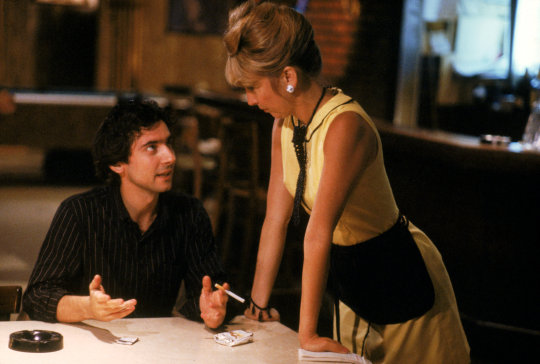
Letterboxd senior editor and podcast co-host Mitchell Beaupre joins us this week and is bringing their favorite film along, and it’s our oldest film yet: Martin Scorsese’s After Hours. In the mid-80s Scorsese was rebounding from his closest call with Oscar yet in Raging Bull and a first attempt to make The Last Temptation of Christ falling apart. In a quick turnaround, he made what some may call his most atypical film and freaked some critics out with its dreamlike, absurd take on male ego. With Griffin Dunne leading a cast that includes a delightful female ensemble of Rosanna Arquette, Teri Garr, Linda Fiorentino, and Catherine O’Hara, the film remains one of Scorsese’s most fascinating.
This episode, we get into the film’s underrated status and the oddball first Independent Spirit Awards where the film took top honors. We also discuss the Globes Comedy races where Dunne was nominated for Best Actor, going long distances for rep screenings, and the 1986 Cannes Film Festival.
Topics also include Ordinary People beating Raging Bull, the Bridesmaids SAG drinking game, and the To Leslie Oscar season surprise campaign.
Links:
The 1985 Oscar nominations
The 1985 Independent Spirit Awards
The 1986 Cannes Film Festival
Vulture Movies Fantasy League
Subscribe:
Spotify
Apple Podcasts
Google Play
Stitcher
youtube
#Martin Scorsese#independent spirit awards#cannes film festival#Griffin Dunne#Teri Garr#Catherine O'Hara#Rosanna Arquette#Linda Fiorentino#John Heard#Golden Globes#Best Director#Academy Awards#Oscars#movies#After Hours
25 notes
·
View notes
Photo
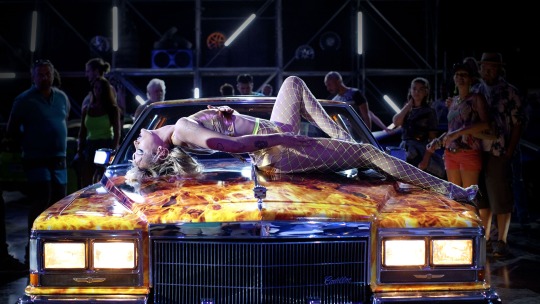
Driven to Love.
With the 2021 Palme d’Or winner in theaters now, Titane filmmaker Julia Ducournau speaks with Letterboxd’s East Coast editor Mitchell Beaupre about destroying societal expectations of gender, the unspoken nature of love, and finding art in a bunch of dancing firefighters.
“I wanted to get to the essence of the person, no matter what their gender is, their sexuality, no matter if they’re from the same family or not. That was the challenge for me, to see if I could make you feel the love.” —Julia Ducournau
Back in 2016, when writer-director Julia Ducournau delivered her debut feature Raw, audiences had no idea what they were in for. While no medical emergencies were reported at its Cannes Film Festival premiere, a Midnight Madness screening at TIFF resulted in ambulances being called in to treat multiple filmgoers who had passed out.
The film earned a mighty reputation, and that was only solidified once it emerged to the public. Perhaps Kat sums it up best: “I left the theater cackling, feeling energized and in love with cinema and life and women—and yet the film also made me anxious and worried and grossed out and violently sad.”
This extreme mixture of emotions wasn’t a one-off for Ducournau, who has followed up that lightning rod of a debut with perhaps an even more headline-grabbing sophomore feature. From the moment Titane debuted at this year’s Cannes, it was clear that it was going to be one of the most talked-about films of 2021.
Reactions out of the fest declared Titane “singular, shocking, repulsive and incendiary”, with Cronenberg comparisons aplenty for this body horror that seeks to reinvent how we see the human anatomy. The Cannes jury awarded the film the Palme d’Or, with jury president Spike Lee so eager to give it the prize that he misunderstood a question at the announcement ceremony and announced it prematurely.
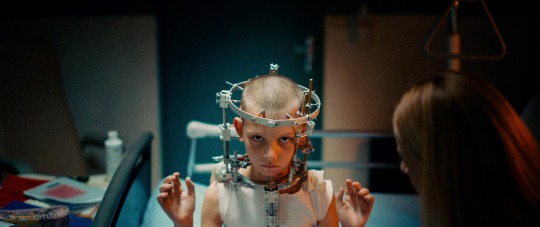
Adèle Guigue as seven-year-old Alexia in ‘Titane’.
The intense reactions out of Cannes were simply the beginning for Titane, which has gone on a barnstorming tour of just about every major festival this year, shocking and awing audiences along the way. Marking Ducournau’s return to TIFF Midnight Madness, Mav took some time to shout out the performances from Agathe Rousselle and Vincent Lindon, while Brittany wrote, “At times I had to watch through my fingers, at other times I was smiling ear to ear”. At NYFF, EJ spoke to the thrill of seeing the film in a theater with an audience “squirming, groaning, whimpering and (nervously) laughing”. Also, just in case you’re wondering, yes there have been more medical emergencies with this one.
Titane defies easy explanation; one can’t really give a brief plot synopsis without getting into spoiler territory. Abandoning the three-act structure, Ducournau’s film is constantly turning, ripping itself apart only to build back together as something entirely new in its explorations of a troubled young woman, Alexia (Rousselle), and a complicated firefighter, Vincent (Lindon).
Mitchell Beaupre straps in to speak with Ducournau about her unique approach to love, how Raw paved the way for her latest feature, and the fascinating arc she takes us on with her main characters.
According to just about everyone on Letterboxd who has seen Titane, you are essentially responsible for saving cinema in 2021. So many reviews are speaking of not only their love for the film, but the specific thrill of watching it in a theater with other humans, sharing intense reactions alongside other people. What does that mean for you to have created such a collective experience? Julia Ducournau: For me, it’s not only meaningful—it’s essential. Titane and Raw were both crafted for the theater. This is in terms of image, obviously, but also with the sound, which is something very much less talked about that makes a huge difference. When you want to create a corporeal experience that is based on your bodily sensations, when you try to make the audience relate to the characters on that deeper level, the sound is something that helps a lot. That’s very specific to sound in the theater.
For example, something I use a lot with my sound designer and my mixer are sub [woofers]. I love subs because they make you feel the scene physically. You feel them through the floor, and you feel them in your chest. However, these subs can disappear very easily if they are not played with the specific amplifiers and sound system. It’s not something you will ever feel on your computer or on your TV, and obviously even less so on your phone. This is something totally linked to the theater experience, and a big part of the sensation I design for you to feel what my characters are feeling down to their skin.
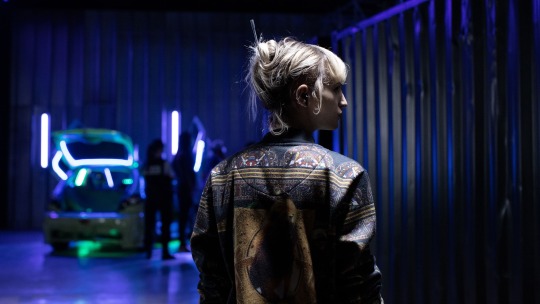
Agathe Rousselle as the adult Alexia in ‘Titane’.
While the film is an extremely effective body horror, another thing we’ve noticed people engaging with more than anything else is the love at the heart of Titane. What compelled you to take audiences on this totally visceral journey that results in such an outpouring of and deep understanding of love? Whew. That’s a bit hard to answer. I decided to put love at the center of Titane because when I was in post-production on Raw, I noticed that while love was present in the film, it was still a sidetrack. I actually began to wonder why I chose that, and if I felt that love was something I could express in a film.
I asked myself this question even more so when the idea is to make you feel what the characters are feeling. How do you make the viewer feel the sensation you have in your body when you love someone? That’s something incredibly difficult.
It was a very interesting challenge to try and aim at that, rather than to talk about love with words. For me, words tend to belittle the feeling a little bit, and also to belittle everything that this film embraces in terms of trying to see past all the presentations that the person in front of you might undergo.
I wanted to get to the essence of the person, no matter what their gender is, their sexuality, no matter if they’re from the same family or not. That was the challenge for me, to see if I could make you feel the love. If I could actually tackle the topic in the unconditional way that I see it. That’s why I decided to do Titane.
I must say, as a non-binary person myself, something that resonated for me personally was the queering of gender in the film. The way that you blur these lines between masculine and feminine, and call into question what those words even mean. How did you want to explore the idea of gender within the film? At the start, it was about trying to have a character that broadens the spectrum of what gender means, but also what our humanity means. I wanted to show that there are a lot more options, and a lot more ‘gazings’ than we actually want to believe there is.
As I was writing the script, I also came to the conclusion that, for me, gender is not relevant in order to define someone. It’s only relevant in terms of societal expectations, which have nothing to do with the individual. I think that it is incredibly limiting to our comprehension of individuality, but also to our comprehension of the interactions we can have with others.
All I tried to do is put the audience in a position of growing empathy with my characters so they would accept the fact that my character is not just one, and she is certainly not what she seems to be. That actually they would accept every single stage of her transformation in order to just admit at the end that she is completely full. That she is one when she’s both Adrien and Alexia, or none of them.
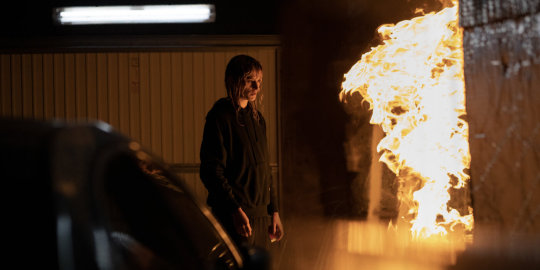
Agathe Rousselle as Alexia, putting her past behind her.
Something that queer people are keenly aware of is the idea of perception, and how perception can often be a threat to people who are pushed aside by society. Could you speak about how that idea of perception played into the way that you wanted to develop the character of Alexia? It’s absolutely central. The way I look at my film, everything has to do with gaze—with the way you look at someone. A lot of people ask me why I use the body-horror grammar, and why I tear the flesh like this, and that’s why. For me, the flesh and the skin is the first barrier of outside representation, and of outside expectation. We have got to shed it. We have to shed the skins one by one in order to try to be free, and basically to be ourselves—or even moreso, to become ourselves, because I tend to see things always as a becoming more than a state.
The way I tried to portray that in my film is actually with the father figures. Alexia’s biological father is a character who never, ever, ever looks at her. He just dismisses her very existence from the start, which makes her someone who doesn’t have any contours. She does not have a clear identity.
That’s why there is an overflow of impulses getting out of her because there is nothing to contain that. She is completely loose, if you wish.
Then she meets Vincent. Where is his headspace when she comes into his life, and what do they find in one another? On the contrary to Alexia, Vincent is a very neurotic character. He’s a character inspired by the movie Vertigo, and how Jimmy Stewart’s character completely sculpts his own fantasy onto Kim Novak.
I insisted on Vincent never being this white knight in shining armor. In his overbearing neurosis he also becomes incredibly intrusive. The thing that makes him different from the biological father is that because of his fantasy, he has to look at her constantly. He wants to sculpt that fantasy. He wants to create it.
At this level, he gives her the contours of someone else, but it so happens that at one point she decides that she feels good in these contours, even though they are the wrong ones. They’re not hers, but she feels good. She decides to adopt those contours, which we see the turn happen when she comes back after leaving, and she doesn’t kill him.
That’s where she decides that she feels better in these contours than in the previous ones she had when she was a woman. After that, she begins to get in touch with her humanity through this relationship. She gets in touch with her emotions, which never happened before, and it makes her feel alive. It’s like for the first time in her life she actually starts to exist.
The challenge for her at this level, and the higher stakes, is to actually show herself for who she is to the person that she came to love—and to be accepted as she is. This lasts until the final moment of the film.
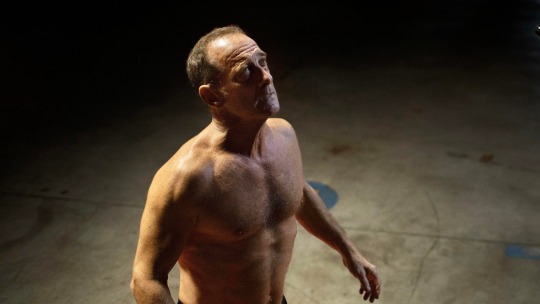
Vincent Lindon, as Vincent, working his body out after hours.
It’s a fascinating arc, as we also see the more she gets in touch with her humanity, the less her body looks human. This is also something very important in the film in terms of where we stand in our own humanity. That’s why at the end she decides to go to him, and to show herself naked, just the way she is. To tell him, “I love you. The way I am now loves you.” You see how it’s a very long journey through, ending on the idea that gender is irrelevant when it comes to identity.
Speaking of that notion of gender in conjunction with how you explore the use of the body in your films, I have to ask you about the pair of firefighter dancing scenes, both of which have a heavy air of homoeroticism. The first is a lovely sequence bathed in this purple light, and later there’s a more aggressive mosh pit. What ideas did you want to draw out in these sequences? In that first one, the homoeroticism that’s present there is debunking the kinds of expectations we could have of firefighters together. It’s again trying to soften this idea of sheer testosterone. Actually, if you look closely, some of the firemen in the background are very good dancers. They have some really good moves, which makes it even more artistic. Somehow it becomes more of a tableaux than just a regular party, which is something I was aiming for. That’s why I used real dancers to play the firemen at this moment. The idea of tableaux is essential, especially when you use slo-mo like this.
As you mentioned, there is a clear difference between the two scenes. With the mosh pit, we used this very white shower light to blend every extra and Adrien together so that they all look alike. They all have shaved heads, big muscles, and are jumping around all over the place. At a certain point, you don’t know who’s who anymore. That’s the intention, as Adrien is at the point where she wants to keep Vincent so badly that she would do anything to blend in completely.
However, this desire to blend in or to belong is something that I see as quite violent. This is not a positive to me. Belonging is never a positive in my mind, for the identity or for the psyche. That’s why it’s so physical and so aggressive.
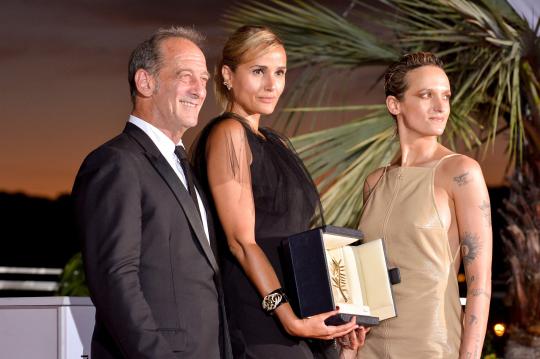
Vincent Lindon, Julia Ducournau and Agathe Rousselle at the 74th Cannes Film Festival. / Photo by Julien Reynaud/APS-Medias
That scene takes a big shift once Alexia gets on top of the truck, and we see her inner self start to come to the surface. When she’s alone on top of the truck, it’s the exact opposite of what the scene was before—the opposite of that violence. She’s on the truck in the form of this pedestal, if you wish, because I tried to instill something that was very sacred there. The firemen look at her either like she’s a Messiah, or they look away because it’s too much to look at. It’s too bright, it’s too strong.
At this level, this is for me the moment where she has moved past this idea of belonging and blending in. She’s feeling herself with both Adrien and Alexia, and something even more. This is her in that moment. There is full grace in this moment, which is what I was aiming at. You see all the way through the film how dance is something I use to go against the audience’s expectations.
On behalf of all Letterboxd film lovers, I want to thank you for your commitment to art that rips open our hearts and brains like this—and as a genderqueer person, thank you for making a film that made me feel so seen. That means a lot to me. Thank you very much, Mitchell.
Related content
Gory B Movie’s list of horror films directed by women from 1900—present
Maxvayne’s extensive list of body-horror films
Bionic Tim’s list of New French Extremity & Modern French Horror, ranked
Follow Mitchell on Letterboxd
‘Titane’ is in theaters now and will be available on VOD from Tuesday, October 19.
#titane#julia ducournau#female director#directed by women#french cinema#cinema du femme#agathe rousselle#vincent london#palme d'or#cannes#tiff midnight madness
6 notes
·
View notes
Note
I love how Mitch has his own tag on your tumblr.
I'm so happy you noticed! I love how Mitch is really attractive.
3 notes
·
View notes
Photo

Balls to the Wall.
With his latest film Prisoners of the Ghostland now in theaters and on VOD, one-of-a-kind filmmaker Sion Sono speaks with Mitchell Beaupre about working with Nicolas Cage, fusing Eastern and Western influences, and drawing from Japanese history for his madcap new creation.
“There was a parity in this film when mashing up those East meets West elements. I wanted to take those unique areas and push them together into one box.” —Sion Sono
Working as a filmmaker since the 1980s, Sion Sono has earned a reputation for being one of the most madcap inventors in the game. His highest-rated film on Letterboxd, 2008’s four-hour-long Love Exposure, currently sits in our Official Top 250 Narrative Feature Films, and is described by Ayush as “an ambitious, outrageously sprawling epic about love, lust, religion, cults, adolescent angst, identity, family, friendship, lies, boners, neglect, rebellion, trauma, and the art of up-skirt photography”.
This gives you an idea of what you may expect to see in a Sion Sono creation, although ultimately nothing can fully prepare you for the things which inhabit his mind. You simply have to see them for yourself.
After more than three decades of prolifically delivering his energetic oddities, occasionally even having multiple films released in the same year, 2021’s Prisoners of the Ghostland marks the first time the Japanese director has made a film in the English language. This isn’t for lack of trying. Sono-san was originally set to helm Lords of Chaos back in 2009 until that production eventually went in a different direction.
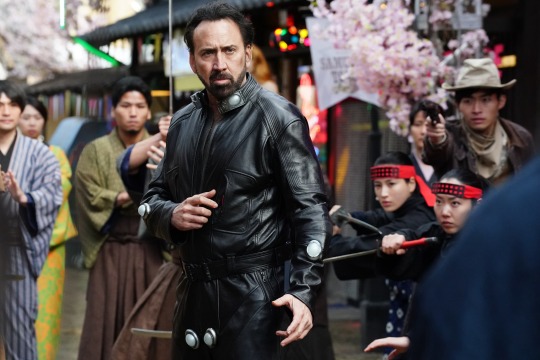
Ghostland came with its own complications, to put it mildly. First announced in December 2018, Nicolas Cage was set to star, with Sono-san intending to shoot the film in Mexico. In February 2019, shortly after Imogen Poots was cast alongside Cage, the director suffered a heart attack, requiring emergency surgery and putting pre-production on halt and the film in jeopardy. Thankfully, he recovered, but was no longer able to shoot outside of Japan, causing a further shift in plans.
In a way, shooting his first English-language project in Japan feels appropriate for the film, with its culture-clashing identity drawing influence from Spaghetti Westerns, samurai films, and so much more. Like the Ghostland depicted in the film, Prisoners of the Ghostland exists somewhere outside of time and location, creating a piece entirely of its own identity.
Premiering in January 2021 at the Sundance Film Festival, Prisoners of the Ghostland earned divisive reviews, not entirely unsurprising for a filmmaker as bold as Sono-san tends to be. While the story was found to be lacking for some, others described it as being “made from the combined love of different cultures, mythology and cinema, but maybe most importantly the love of art in sets, props and practical effects”.
Cage plays the film’s protagonist, appropriately named Hero, who is serving time in Samurai Town for a bank robbery gone wrong. Hero is released thanks to a nefarious villain known as The Governor (Bill Moseley), who hires him to find and rescue his missing granddaughter (Sofia Boutella, replacing Poots) in exchange for his freedom. The journey—Hero’s Journey, if you will—takes Cage into a post-apocalyptic wasteland that features one of the most elaborate sets of Sono’s career.
With producer Ko Mori translating, Sion Sono sat down with Mitchell Beaupre to discuss making his first English-language project, using the costumes and sets to bring vivid color to the film, and his favorite Nicolas Cage movie.
You had been wanting to make your English-language debut for a while now, originally having it set to be Lords of Chaos, over a decade ago. Was there something pulling you towards making a film in English? Sion Sono: I feel that the American audience, and European audience, seem to like my films more than the Japanese audience. Thinking about this gave me the idea that maybe I should just go ahead and start shooting in English, so that the film is already for those audiences.
In Prisoners of the Ghostland you draw from an array of cinematic influences, from Spaghetti Westerns to samurai films to post-apocalyptic wastelands. Was it exciting to take these different areas and fuse them together into something totally unique? There was a parity in this film when mashing up those East-meets-West elements. I wanted to take those unique areas and push them together into one box. The result was creating something in between those two worlds, and thus it became completely original, which was an idea I really liked to explore.
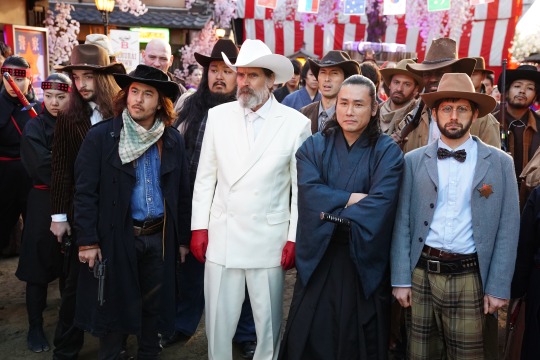
Bill Moseley (in white) as The Governor and Tak Sakaguchi (with sword) as Yasujiro.
In terms of cinematic touchstones, one thing I found particularly interesting was the costuming choices. We see Nicolas Cage’s protagonist dressed in all-black leather, whereas Bill Moseley’s villain is wearing a nice, clean white suit with these striking red gloves. Was there an intentional subversiveness there? That’s a great question. At the end of the day, the story of the film is quite simple. Because of that, I wanted to make a difference in terms of the details. Part of those details became using the costumes in a unique way. For instance, the film has samurai costumes, but also Western cowboy costumes. I had specific ideas for using bright, vivid colors so that it makes the film stand out visually. As you mentioned, that can be seen in The Governor and his clean white suit which really contrasts with the rest of the color palette in the film.
Another striking element of the film is the Ghostland itself, which is such a massive, complicated set. What was the process of putting that location together? Along with wanting to use the costume design to make the film stand out when the story is rather simple, I was motivated to do the same thing with the production design. The Ghostland set took a tremendous amount of effort. I didn’t want to use any CGI for it. I would much rather make it all happen in a physical way. That became very difficult to figure out with all of the sets, including the Ghostland. I just wanted to make something super interesting.
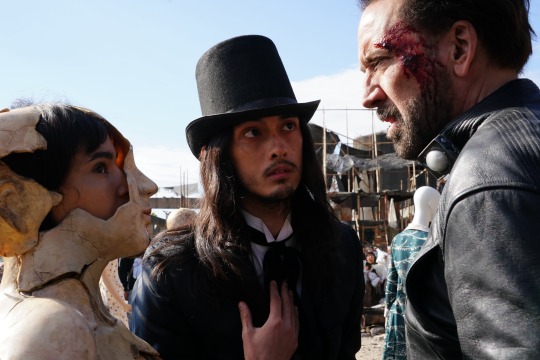
Sofia Boutella as Bernice, Jai West as Jay and Nicolas Cage as Hero.
You’ve mentioned how you incorporated Japanese history, such as the nuclear events in Fukushima and Hiroshima, into the fabric of the film and the construction of the Ghostland set. Could you tell me more about that? There was a little bit of that element already in the original script. I was able to draw that out, to make it clearer and convey a larger idea regarding atomic energy. Since we were shooting in Japan, the idea of that became even more prevalent in my mind, when thinking about things like Hiroshima and Fukushima.
A great example of this is when you see the clocktower in the Ghostland, and the Ghostlanders are trying to keep the time, or the clock, from moving. They’re trying to hold onto time. The clock is set one minute before 8:15, which is the time that the atomic bomb was dropped on Hiroshima. In the Ghostland, the time is 8:14, and they are trying to stop it from moving because they think once it hits 8:15, then the explosion will happen.
I’d love to talk about Nicolas Cage for a bit. He’s an actor who at this point has an otherworldly, almost supernatural mythos to him. What was your experience like getting to know him, both as an actor, and as a human being? When Nic Cage and I first met, he had already seen some of my films. Once he came on board the project, though, he went off and watched almost every single one of my films, to have a better understanding of me as a filmmaker. Before we shot the film, Nic went to Hiroshima in order to do some research for himself to try [to] understand the history of Japan. He did so much of his own research, including talking to many people to educate himself further on Japan, and on Japanese culture. That’s the kind of man Nic Cage is.

Sion Sono behind the scenes of ‘Prisoners of the Ghostland’.
Did Nic mention if he has a favorite film of yours? Yes, his favorite film of mine is called Antiporno.
I just saw that for the first time this year and it blew me away. Thank you very much.
Do you have a favorite Nicolas Cage film? There are so many that I like, or love, but I would probably say Leaving Las Vegas is the one that is my favorite.
To wrap up, I’d love to know what film was the one which first made you realize you wanted to become a filmmaker? There were a lot growing up, but when I was young I saw Steven Spielberg’s Jaws, and that was the film which really made me think that maybe I should be a filmmaker.
Related content
Hibiscus’ list of Japanese films that will blow your mind and make you reevaluate the possibilities of the cinematic artform
Darren’s list of high-art genre movies
Follow Mitchell on Letterboxd
‘Prisoners of the Ghostland’ is out now in US theaters, on demand and on digital.
#letterboxd#nicolas cage#nic cage#sion sono#japanese cinema#japanese film#western#action adventure#sofia boutella
4 notes
·
View notes
Photo
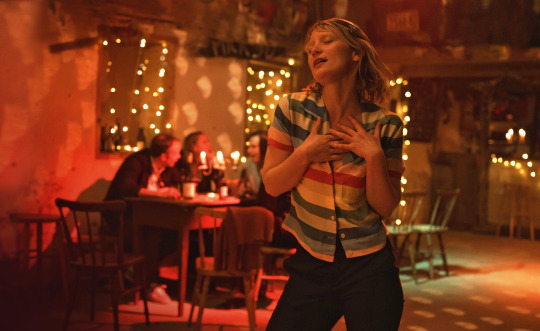
Fårö and Away.
Away from the breathtaking island of Fårö, Letterboxd’s East Coast Editor Mitchell Beaupre speaks with Bergman Island filmmaker Mia Hansen-Løve about all things Bergman, finding the balance between your art and your relationships, and the sex appeal of Elliott Gould.
“I think one of the first things that made me love the films of Bergman is the way he films women, actually… Who can pretend to have filmed women better than he did?” —Mia Hansen-Løve
Fårö, an island in the Baltic Sea off Sweden’s south-eastern coast, is a popular summer vacation spot, with its own language (a dialect of Gutnish called Faroymal). It was also the home of the great filmmaker Ingmar Bergman, who fell in love with the island once he set foot on it in 1960. He made many films there, including Through a Glass Darkly, Persona and Hour of the Wolf, eventually staying there for the final years of his life, until his death in 2007.
Since his passing, Bergman’s estate on Fårö has been turned into an artists’ retreat where guests can now visit and stay at the place Bergman called home. There you can visit the Bergman Center, a cultural destination for those seeking to celebrate the filmmaker’s art and life. Each year, the center hosts a five-day event called Bergman Week, where films are screened alongside discussions, music and lectures. Special guests for Bergman Week over the years have included Yorgos Lanthimos, Harriet Andersson, Greta Gerwig, Noah Baumbach, Tim Roth and Mia Hansen-Løve (writer and director of Goodbye First Love and Things to Come).
Hansen-Løve’s affinity for Fårö and for Bergman’s work made the island the natural location for her latest feature, appropriately titled Bergman Island. The film stars Vicky Krieps as Chris, a filmmaker who arrives on Fårö with her husband Tony (repeat Fårö visitor Tim Roth). Tony is the more accomplished filmmaker of the duo, and is being showcased on the island. As their time there continues, Hansen-Løve blurs the line between fiction and reality for both the audience and the characters, charting a metafictional course that sees Chris’ art inspired by her life, just as Bergman Island is inspired by Hansen-Løve’s.
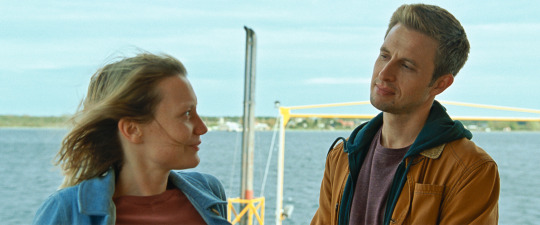
Mia Wasikowska and Anders Danielsen Lie in ‘Bergman Island’.
After a rocky production, which saw actors Greta Gerwig, John Turturro and Owen Wilson all cast in the leading roles at various points before having to drop out, Bergman Island made its premiere at this year’s Cannes Film Festival, before going on a run that included stops at Telluride, TIFF and NYFF.
With its fondness for Bergman permeating through each scene, and a cast that also includes Mia Wasikowska and Anders Danielsen Lie, “this one is surely for the Letterboxd users”, Ethan writes in his review. A look through other reviews proves Ethan’s statement largely correct. Ash appreciates the way Hansen-Løve finds inspiration from Bergman to tell her own story, as opposed to being a more direct homage. For Jervis, it was “everything I love in art”. And, of course, it must be said: this has truly been quite the “big year for Vicky Krieps and beaches”.
As Bergman Island at last reaches audiences beyond festivals, Hansen-Løve sat down with Mitchell Beaupre to discuss her relationship with Bergman’s work, with Fårö itself, and how this film allowed her to reach a new level of maturity in her filmmaking.
What was the first Ingmar Bergman film you saw, and what was your response to that introduction to his work? Mia Hansen-Løve: I think I was in my twenties when I first saw films by him. There was a retrospective of his work at an old historical cinematheque in Paris. The very first one I saw was Summer with Monika, one of his early films. The Nouvelle Vague guys at that time elected that film as being the symbol of modern cinema because Bergman was filming young people in love in a way that was different to what had been shown on film before then.
It wasn’t shot in Fårö, I think it was shot in the archipelagos of Stockholm, but he was shooting outside locations, which was also quite unique. It was breaking all the rules in terms of what cinema was doing, in terms of how these young characters were living, and especially about the way he filmed women. I think one of the first things that made me love the films of Bergman is the way he films women, actually.

Director Mia Hansen-Løve on the set of ‘Bergman Island’.
Some people have felt that Bergman Island suggests Bergman was a bit sexist, but you actually feel quite the opposite. Yes, the comments in my film on the way he behaved with his kids has led to people thinking I’m criticizing his relationships with women, but I actually admire him for being one of the directors who filmed the most beautiful portraits of women ever in cinema. Who can pretend to have filmed women better than he did? That’s one of the things that makes his films so significant to me—how much importance he gave to women at a time where most directors were giving that space to men in their films.
That would be enough, but then his films take up such a big territory for me because he’s made so many films, and all of them are made with the same independence and freedom. He wrote all of his films, and they all came from his desire to express something. They were never imposed from the outside. Few directors ever reached that same degree of integrity and independence, and I admire that so much.
Was there anything about his relationship with Fårö that connected with you personally? He wasn’t the most social person, and that’s something that attracts me somehow in terms of his relationship with the island and what that means when it comes to loneliness. I cannot afford to live the way he did. I have a kind of life with family and obligations that make it impossible for me to live on a remote island. I wouldn’t want to live like that because I don’t have the strength, but I do admire that way of living, as he did for the last twenty years of his life.
You’ve said that while you don’t have a favorite Bergman film, you do have a special relationship with his 1971 film, The Touch. That’s a unique pick. What makes that film stand out so much for you? I think it has to do with the fact that it’s not a cerebral film of his. It’s a film that I find very direct, very innocent, especially compared to other films he made in the same period. As a young director he made those films like Summer with Monika that were more direct, and also very sensual, and focused on love, relationships, passion, and things like that. But afterwards his films were more complex, and would tackle more aesthetic quests, more formal quests.
The Touch isn’t one of his most famous films. It’s been quite forgotten, and Bergman himself didn’t like it for some reason. What I like about it so much, though, is its simplicity. I find the film extremely sincere and incarnated. The presence of Elliott Gould in the film—an American actor—allowed Bergman to explore things about sexual relationships that he wouldn’t be able to say with his regular Swedish actors.
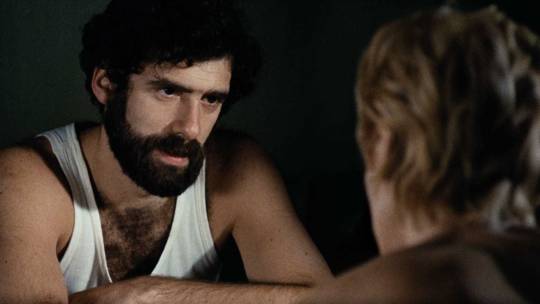
Elliott Gould and Bibi Andersson in Ingmar Bergman’s ‘The Touch’ (Beröringen, 1971).
There is certainly an innate sexuality that comes into play once you bring Elliott Gould into the mix. He brought something in from the outside, with his American culture, his presence, charisma, sex appeal or whatever you call it, that was actually telling something from the inside to me. It’s very paradoxical, but I feel that Elliott Gould enabled Bergman to say something more about himself that his other films couldn’t say. There is something brutal and animalistic about him in the film, and I think that reveals something about Bergman himself. That actually moves me a lot, for some reason. The film touches me. I saw it again a few days ago, and it still has the same power for me.
It reminds me of some of Truffaut’s films that are about the power of passion in your life, and how it takes up all the space. The film shows that brutality of passion. I find that extremely powerful and beautiful, and I don’t know any other film of Bergman’s that’s like that.
Bergman Island focuses on two filmmakers who are in a relationship, and it makes interesting observations on the kinds of boundaries you have to set to be able to create while also being in a relationship with another person. It’s a difficult balance to navigate. What I wanted to do with this film was to show the difficulty, and also maybe the beauty, of being in a couple where both are writers, or artists. They both have their own quest, yet they’re still trying to be together. What does it mean to be together and at the same time lonely? How do you find the balance between this necessary loneliness that comes with being an artist? Bergman incarnates that so perfectly—the loneliness, but also the power that comes with the solitude of an artist.
On the other hand, most human beings want to be in a couple because they want to have an exchange. They want to have a dialogue. They want to feel close to somebody. They want love. These are very universal, and human feelings that anybody can understand, but then how can you cope with that solitude of the artistic quest? My film really tries to deal with that.

Vicky Krieps and Tim Roth in ‘Bergman Island’.
While the film is told from Chris’s perspective, there’s still a dimensionality to the portrayal of Tony, where he’s never seen as a villain, or an antagonistic force against her. I don’t think the film wants to judge anybody. I didn’t make the film in order to go against the male character. I know there is more empathy in the film for her, because it’s more of a portrait of her, so we understand her more than him. He is more distanced from her, and that distance becomes more and more as the film goes on, as we get closer to her. I’m aware of that, but I never made the film against him. At the end, they are still together. I just wanted to show the difficulty and the vulnerability that comes when you are together, but lonely at the same time.
Navigating that relationship in the film must have been a little tricky, considering the production difficulties. You had several actors set to play Tony who dropped out, leading to you shooting half of the film with just Vicky Krieps, and not even knowing who was going to play Tony yet. There was, of course, a challenge to shoot like this—to shoot only half of the film, and then have to wait to shoot the other half. We were editing certain scenes without even knowing who was going to play the husband. It was a little bit insane, a bit schizophrenic.
While it was challenging in some aspects, was there also a surprising benefit to doing it this way? Particularly given the nature of the film? Yes, I think it’s a film that from the start was meant to take time. I’ve had this idea in my mind for more than ten years. Even before knowing I would set it on Fårö, the idea of making a film about a director couple was with me as I was doing other films. I let that film grow by itself until I found the idea of setting it on Fårö. It feels fitting that it would take me two years to shoot the film, and I’d have to leave and go back there.
I ended up going to Fårö each year for four or five years. I spent months on the island. I know every inch of the island now. I think that was part of the project. That’s the time I had to let pass in order to finish the film. That took a lot of patience, and that patience brought a maturity to the film. There is something peaceful and quiet about this film that makes it a bit different from my previous films.
Related content
Velma’s list of Scandi Films
Ingmar Bergman’s Fårö Island—a list of Bergman films shot on the island
Calvin’s list of Fårö Island filmography
Follow Mitchell on Letterboxd
‘Bergman Island’ is playing in US theaters now, and will be available on VOD from October 22.
5 notes
·
View notes